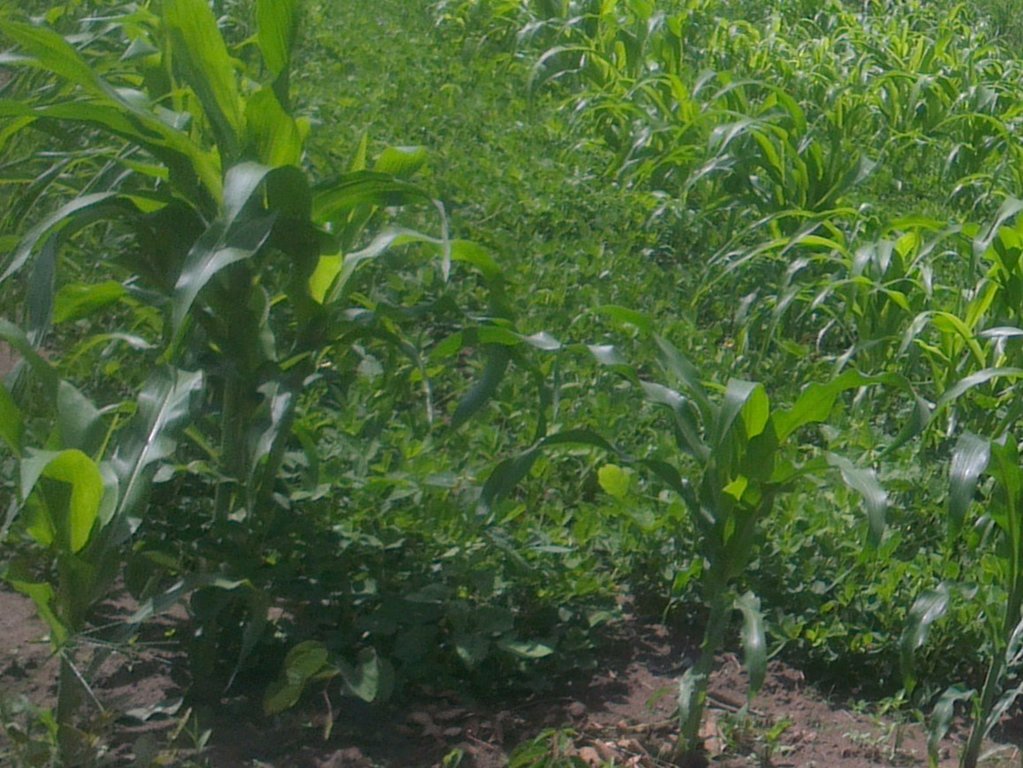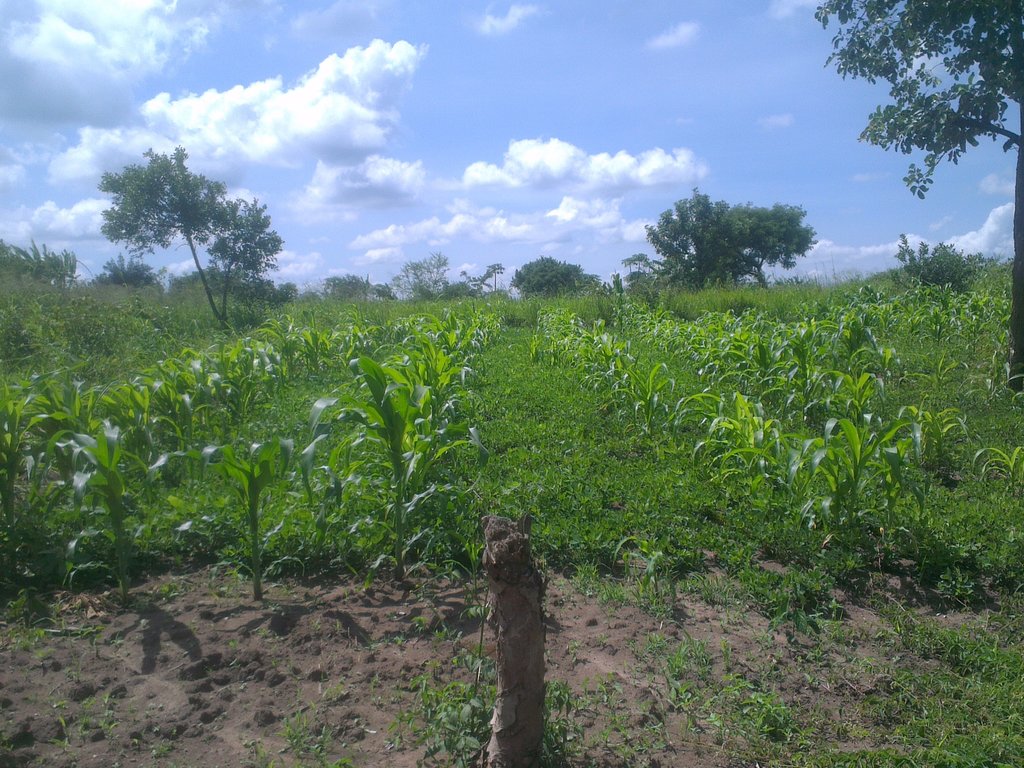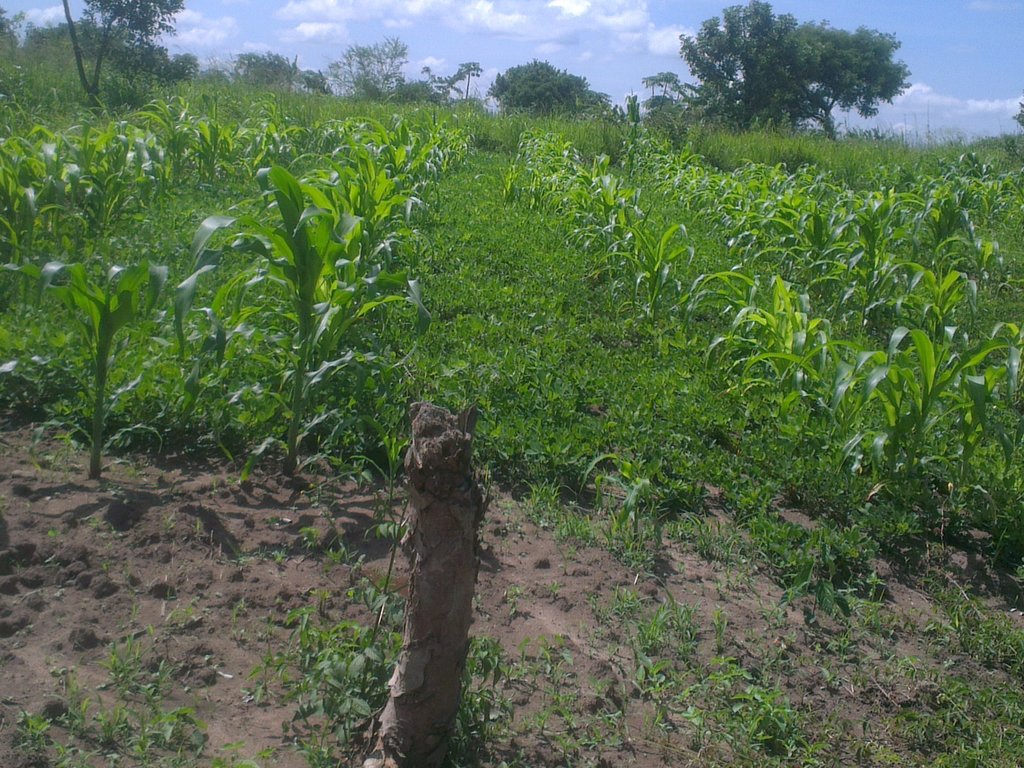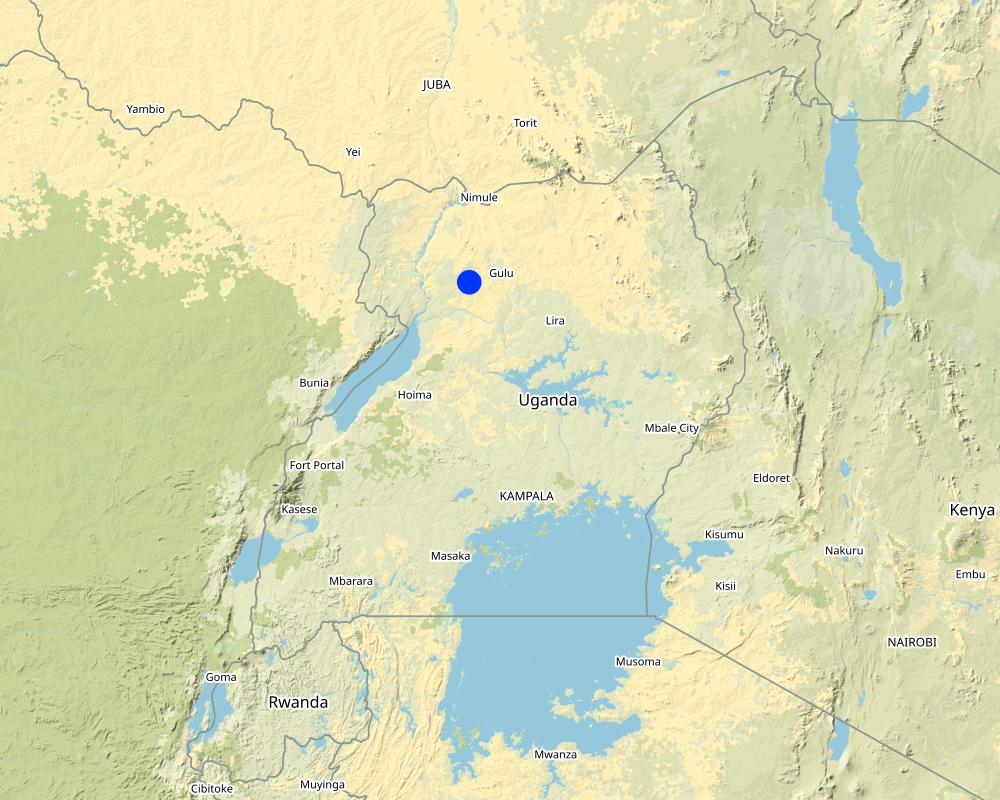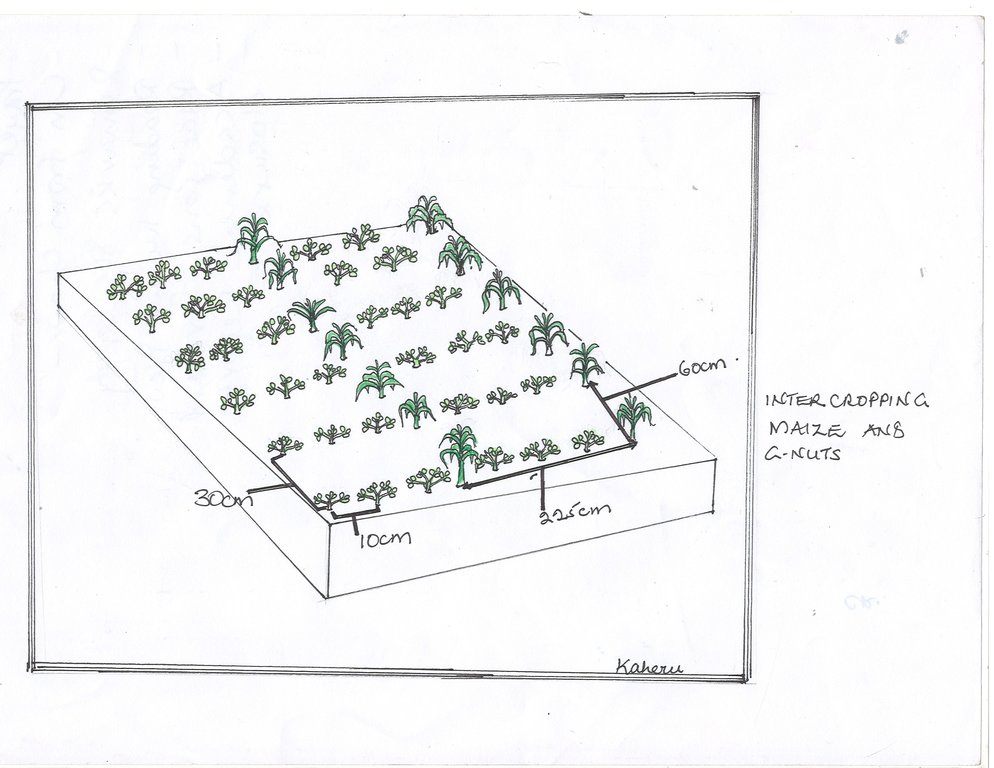Intercropping Maize and Ground Nuts for Optimum Land Utilisation, Increased Food Production, Household Income and Food Security [乌干达]
- 创建:
- 更新:
- 编制者: Jalia Namakula
- 编辑者: Kamugisha Rick Nelson
- 审查者: Udo Höggel, John Stephen Tenywa, Nicole Harari, Joana Eichenberger
Rub Kodi
technologies_2929 - 乌干达
- Intercropping Maize and Ground Nuts for Optimum Land Utilisation, Increased Food Production, Household Income and Food Security: Aug. 18, 2022 (inactive)
- Intercropping Maize and Ground Nuts for Optimum Land Utilisation, Increased Food Production, Household Income and Food Security: Nov. 18, 2022 (public)
查看章节
全部展开 全部收起1. 一般信息
1.2 参与该技术评估和文件编制的资源人员和机构的联系方式
关键资源人
土地使用者:
Ocen Francis
Riber Farmers Group
乌干达
有助于对技术进行记录/评估的项目名称(如相关)
Scaling-up SLM practices by smallholder farmers (IFAD)有助于对技术进行记录/评估的机构名称(如相关)
CDE Centre for Development and Environment (CDE Centre for Development and Environment) - 瑞士1.3 关于使用通过WOCAT记录的数据的条件
编制者和关键资源人员接受有关使用通过WOCAT记录数据的条件。:
是
1.4 所述技术的可持续性声明
这里所描述的技术在土地退化方面是否存在问题,导致无法被认为是一种可持续的土地管理技术?:
否
注释:
Inter cropping cereal and legume based systems aims at maximizing the production potential per unit area .
2. SLM技术的说明
2.1 技术简介
技术定义:
Improved maize (zea mays)-groundnuts (arachis hypogaea) optimum intercropping pattern is a technology promoted by IITA (International Institute for Tropical Agriculture) among small scale farmers through demonstrations /trials. It is promoted for improving food and income security and optimum land utilisation.
2.2 技术的详细说明
说明:
The International Institute of Tropical Agriculture (IITA) has been promoting smart intercropping patterns in Nwoya District, Northern Uganda. The inter crops promoted are based on maize-legume sustainable intensification farming systems with focus on conservation farming as a technology. This technology is promoted because it reduces management inputs costs such as labour for weeding and application of fertilizers which results into sustainable systems and if efficiently used to potentially replenish natural resources.The demonstration/ trial is located in Alero Sub County, Nwoya District, which on average receives 1200 mm of rainfall annually established on a reddish soil with relatively low soil organic matter on a plot size of 180 m2 planted with groundnuts as the major crop spaced at 30cm×10cm and maize intercrop at a spacing of 225 cm×60cm, such that within every 5 lines of groundnuts one line of maize is planted.
The groundnuts (local red variety called red beauty) are locally obtained from the nearby local market, while the maize is an open pollinated variety (Longe 5) bought from the local agro input dealer. The inter crop was planted to increase productivity and reduce the risk of total crop failure.
Prior to establishment, Riber farmers group selected a site close to the road to act as there demo/plot.The plot was slashed, sprayed with glyphosate and then marked using 60-cm pegs to get the correct spacing and proper plant population. Ground nuts were planted first then the maize planted a fortnight later using the following inputs 3 kg of maize bought at UGX 1500, 15 kg of groundnuts bought at UGX 5000 and 1 litre of liquid fertiliser at UGX 15000 and 1 litre of glyphosate bought at UGX 20,000.
Inter cropping is majorly preferred by farmers because it enhances maximum utilization of land, reduces risk of total crop failure, and increases income and food security. It also acts as a means of weed management. In some inter cropping systems, the legumes act as soil cover and fix atmospheric nitrogen in the soil, and promote product diversity for food security and income generation.
However weeding an inter crops is challenging compared to weeding a pure stand and encourages competition for resources such as soil nutrients, moisture and light, which may affect crop productivity. Its therefore recommend that the farmer keep in touch with the extension worker for advisory services ( proper management, pests and diseases management)
2.3 技术照片
2.4 技术视频
日期:
28/04/2017
位置:
Alero sub-county Nwoya District
摄影师的名字:
Jalia Namakula
2.5 已应用该技术的、本评估所涵盖的国家/地区/地点
国家:
乌干达
区域/州/省:
Northern Uganda
有关地点的进一步说明:
Bwobo nam, Alero Sub-county,Nwoya District
具体说明该技术的分布:
- 均匀地分布在一个区域
如果不知道精确的区域,请注明大致覆盖的区域:
- < 0.1 平方千米(10 公顷)
Map
×2.6 实施日期
注明实施年份:
2016
如果不知道确切的年份,请说明大概的日期:
- 不到10年前(最近)
2.7 技术介绍
详细说明该技术是如何引入的:
- 通过项目/外部干预
注释(项目类型等):
The intercropping pattern was introduced by International Institute for Tropical Agriculture (IITA)
3. SLM技术的分类
3.1 该技术的主要目的
- 改良生产
- 创造有益的经济影响
3.2 应用该技术的当前土地利用类型

农田
- 一年一作
每年的生长季节数:
- 2
具体说明:
The intercrop is done twice annually but the legumes change every season, sometimes soybean is planted instead of groundnuts (March-August and September-December)
注释:
The demonstration site is located by the road side. It is surrounded by bush fallows and a small banana plantation (musa spp)
3.4 供水
该技术所应用土地的供水:
- 雨养
注释:
The group depends on rain fall for growing crops on this plot.
3.5 该技术所属的SLM组
- 土壤肥力综合管理
- 改良植物品种/动物品种
3.6 包含该技术的可持续土地管理措施

农艺措施
- A1:植被和土壤覆盖层
- A2:有机质/土壤肥力
- A5:种子管理,改良品种
注释:
The groundnuts act as a soil cover and also fix nitrogen in the soil improving soil fertility
3.7 该技术强调的主要土地退化类型

土壤水蚀
- Wt:表土流失/地表侵蚀

化学性土壤退化
- Cn:肥力下降和有机质含量下降(非侵蚀所致)

生物性退化
- Bl:土壤寿命损失
注释:
The demo plot was established on an intensely cultivated area, the legumes are planted to improved soil fertility . in addition the groundnuts act as a soil cover therefore reducing soil erosion.
3.8 防止、减少或恢复土地退化
具体数量名该技术与土地退化有关的目标:
- 防止土地退化
注释:
The ground nuts are inter cropped to not only increase crop diversity on the plot but to also reduce soil erosion incidence.
4. 技术规范、实施活动、投入和成本
4.1 该技术的技术图纸
4.2 有关投入和成本计算的一般信息
具体说明成本和投入是如何计算的:
- 每个技术区域
注明尺寸和面积单位:
180m2
如果使用本地面积单位,注明转换系数为1公顷(例如1公顷=2.47英亩):1公顷=:
0.018 ha
其它/国家货币(具体说明):
UGX
如相关,注明美元与当地货币的汇率(例如1美元=79.9巴西雷亚尔):1美元=:
3680.0
注明雇用劳工的每日平均工资成本:
3000/=
4.3 技术建立活动
| 活动 | 时间(季度) | |
|---|---|---|
| 1. | Bush clearing | January |
| 2. | Slashing and spraying | January |
| 3. | Field marking | January |
| 4. | Planting both maize and beans | March |
4.4 技术建立所需要的费用和投入
| 对投入进行具体说明 | 单位 | 数量 | 单位成本 | 每项投入的总成本 | 土地使用者承担的成本% | |
|---|---|---|---|---|---|---|
| 劳动力 | Slashing | People | 15.0 | 3000.0 | 45000.0 | 100.0 |
| 劳动力 | Ploughing | People | 15.0 | 3000.0 | 45000.0 | 100.0 |
| 劳动力 | Field Marking | People | 15.0 | 3000.0 | 45000.0 | 100.0 |
| 劳动力 | Planting | People | 15.0 | 3000.0 | 45000.0 | 100.0 |
| 设备 | Strings | Piece | 1.0 | 8000.0 | 8000.0 | 100.0 |
| 设备 | Planting Pegs | bundle | 2.0 | 5000.0 | 10000.0 | 100.0 |
| 设备 | Tape Measure | Piece | 1.0 | 25000.0 | 25000.0 | 100.0 |
| 植物材料 | Groundnuts | kg | 15.0 | 2500.0 | 37500.0 | 100.0 |
| 植物材料 | Longe5 (maize) | kg | 3.0 | 1500.0 | 4500.0 | 100.0 |
| 肥料和杀菌剂 | Liquid fertiliser (DI grow) | Ltr | 1.0 | 15000.0 | 15000.0 | 100.0 |
| 技术建立所需总成本 | 280000.0 | |||||
注释:
IITA introduced the technology to the farmers group however establishment and maintenance costs were incurred by the group
4.5 维护/经常性活动
| 活动 | 时间/频率 | |
|---|---|---|
| 1. | Weeding | April |
| 2. | Spraying | fort night |
注释:
Weeding is done once because the ground nuts close the canopy therefore inhibiting weeds growth.
4.6 维护/经常性活动所需要的费用和投入(每年)
| 对投入进行具体说明 | 单位 | 数量 | 单位成本 | 每项投入的总成本 | 土地使用者承担的成本% | |
|---|---|---|---|---|---|---|
| 劳动力 | Weeding | people | 15.0 | 3000.0 | 45000.0 | 100.0 |
| 劳动力 | spraying | people | 1.0 | 3000.0 | 3000.0 | 100.0 |
| 设备 | knapsacks sprayer | Piece | 1.0 | 55000.0 | 55000.0 | 100.0 |
| 技术维护所需总成本 | 103000.0 | |||||
如果土地使用者负担的费用少于100%,请注明由谁负担其余费用:
The group incurred all the costs
4.7 影响成本的最重要因素
描述影响成本的最决定性因素:
Labour is the most important factor affecting costs.
5. 自然和人文环境
5.1 气候
年降雨量
- < 250毫米
- 251-500毫米
- 501-750毫米
- 751-1,000毫米
- 1,001-1,500毫米
- 1,501-2,000毫米
- 2,001-3,000毫米
- 3,001-4,000毫米
- > 4,000毫米
指定年平均降雨量(若已知),单位为mm:
1100.00
有关降雨的规范/注释:
The first season starts in March-June , season 2016A and B the rains have not been sufficient, the second season starts in September -November and the dry spell begins in December - March
农业气候带
- 潮湿的
5.2 地形
平均坡度:
- 水平(0-2%)
- 缓降(3-5%)
- 平缓(6-10%)
- 滚坡(11-15%)
- 崎岖(16-30%)
- 陡峭(31-60%)
- 非常陡峭(>60%)
地形:
- 高原/平原
- 山脊
- 山坡
- 山地斜坡
- 麓坡
- 谷底
垂直分布带:
- 0-100 m a.s.l.
- 101-500 m a.s.l.
- 501-1,000 m a.s.l.
- 1,001-1,500 m a.s.l.
- 1,501-2,000 m a.s.l.
- 2,001-2,500 m a.s.l.
- 2,501-3,000 m a.s.l.
- 3,001-4,000 m a.s.l.
- > 4,000 m a.s.l.
说明该技术是否专门应用于:
- 不相关
5.3 土壤
平均土层深度:
- 非常浅(0-20厘米)
- 浅(21-50厘米)
- 中等深度(51-80厘米)
- 深(81-120厘米)
- 非常深(> 120厘米)
土壤质地(表土):
- 中粒(壤土、粉土)
土壤质地(地表以下> 20厘米):
- 细粒/重质(粘土)
表土有机质:
- 中(1-3%)
5.4 水资源可用性和质量
地下水位表:
5-50米
地表水的可用性:
匮乏/没有
水质(未处理):
良好饮用水
水的盐度有问题吗?:
否
该区域正在发生洪水吗?:
否
关于水质和水量的注释和进一步规范:
The water is drawn from the borehole and considered of good quality and is readily available
5.5 生物多样性
物种多样性:
- 中等
栖息地多样性:
- 中等
5.6 应用该技术的土地使用者的特征
定栖或游牧:
- 定栖的
生产系统的市场定位:
- 混合(生计/商业)
非农收入:
- 低于全部收入的10%
相对财富水平:
- 贫瘠
个人或集体:
- 团体/社区
机械化水平:
- 手工作业
性别:
- 女人
- 男人
土地使用者的年龄:
- 中年人
说明土地使用者的其他有关特征:
They are a farmer's group with a membership of 35(20Males and 15Females) they are all small scale farmers
5.7 应用该技术的土地使用者使用的平均土地面积
- < 0.5 公顷
- 0.5-1 公顷
- 1-2 公顷
- 2-5公顷
- 5-15公顷
- 15-50公顷
- 50-100公顷
- 100-500公顷
- 500-1,000公顷
- 1,000-10,000公顷
- > 10,000公顷
这被认为是小规模、中规模还是大规模的(参照当地实际情况)?:
- 小规模的
注释:
general land sizes owned by members is 2 acres
5.8 土地所有权、土地使用权和水使用权
- Customary
- Customary
用水权:
- 社区(有组织)
注释:
The land is owned by the clan and is passed on to family members
5.9 进入服务和基础设施的通道
健康:
- 贫瘠
- 适度的
- 好
教育:
- 贫瘠
- 适度的
- 好
技术援助:
- 贫瘠
- 适度的
- 好
就业(例如非农):
- 贫瘠
- 适度的
- 好
市场:
- 贫瘠
- 适度的
- 好
能源:
- 贫瘠
- 适度的
- 好
道路和交通:
- 贫瘠
- 适度的
- 好
饮用水和卫生设施:
- 贫瘠
- 适度的
- 好
金融服务:
- 贫瘠
- 适度的
- 好
6. 影响和结论性说明
6.1 该技术的现场影响
生态影响
土壤
土壤覆盖层
注释/具体说明:
They act as a soil cover
6.4 成本效益分析
技术收益与技术建立成本相比如何(从土地使用者的角度看)?
短期回报:
稍微积极
长期回报:
稍微积极
技术收益与技术维护成本/经常性成本相比如何(从土地使用者的角度看)?
短期回报:
积极
长期回报:
积极
注释:
The intercrops are an annual enterprise therefore benefts are realised in the short term. the group indicated that they planted one(1) kg of maize seed the previous season and got 200kgs after harvesting. however in this particular season the harvests were not yet made
6.5 技术采用
- 11-50%
如若可行,进行量化(住户数量和/或覆盖面积):
The group has a membership of 35 people all the group members have transffered the technology into their own farms.
在所有采用这项技术的人当中,有多少人是自发的,即未获得任何物质奖励/付款?:
- 51-90%
注释:
All the members received seed from the proceeds of the previous season from the group demo and were supposed to transfer the technology to their different individual farms.
6.6 适应
最近是否对该技术进行了修改以适应不断变化的条件?:
否
6.7 该技术的优点/长处/机会
| 土地使用者眼中的长处/优势/机会 |
|---|
| The technology is good at Improving crop yield due to the crop, nutrients, fertility |
| Inter cropping leads to weed suppression |
| The technology controls pest and disease incidence. |
| 编制者或其他关键资源人员认为的长处/优势/机会 |
|---|
| Legumes act as soil cover hence reduction in soil moisture |
| Reduces risk of total crop failure. In case the drought starts early the farmer would have already harvested the legumes. |
| Improve soil fertility resulting from the legumes fixing nitrogen in the soils |
6.8 技术的弱点/缺点/风险及其克服方法
| 土地使用者认为的弱点/缺点/风险 | 如何克服它们? |
|---|---|
| Weeding in intercrops is cumbersome | weed when crops are still young |
| It is not easy to use chemical weed control in intercrops | This is overcome by spraying weeds before planting hence reducing on their vigour and also weeding early |
| sometimes the right plant population is not got reducing on the crop yields of intercrops | This is overcome by marking the correct spacing of the major crop to atleast get optimum plant population for the major crop |
| 编制者或其他关键资源人员认为的弱点/缺点/风险 | 如何克服它们? |
|---|---|
| some times there is competition for nutrients and water between the crops | Applying of basal nitrogenous fertilisers |
| Sometimes inter cropping may lead to entiolation and poor growth of crops | This can be overcome by planting the legume before planting the cereal. This is done to allow the legumes grow fast so as they dont get affected by too mush shade |
| Late maturing crops are usually damaged during harvesting of the early maturing crops | This is overcome by planting in rows and being careful while harvesting the early maturity crops. |
7. 参考和链接
7.1 信息的方法/来源
- 实地考察、实地调查
1
- 与土地使用者的访谈
1
(现场)数据是什么时候汇编的?:
12/5/2017
7.2 参考可用出版物
标题、作者、年份、ISBN:
Effect of Summer Maize-Legume Intercropping System on Growth, Productivity, Pilli Manassa , 2018
可以从哪里获得?成本如何?
Open access
7.3 链接到网络上的相关信息
标题/说明:
Maize/peanut intercropping increases land productivity: A meta-analysis
URL:
https://www.sciencedirect.com/science/article/pii/S0378429021001544
链接和模块
全部展开 全部收起链接
无链接
模块
无模块



